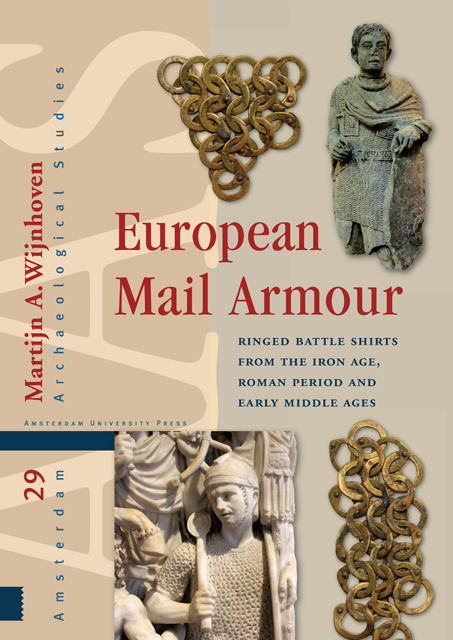Book contents
- Frontmatter
- Contents
- Acknowledgements
- Dedication
- 1 Introduction
- 2 The origins of mail armour
- 3 Distribution and archaeological context
- 4 The iconography of early mail armour
- 5 The naming of mail armour
- 6 Decoration in mail garments
- 7 Padded garments
- 8 The craft of making mail rings
- 9 Weaving patterns
- 10 The construction of mail garments
- 11 Ring characteristics
- 12 Final considerations
- Bibliography
- Database
- Appendix 1 Catalogue of mail armour
- Appendix 2 Catalogue of hybrid armour
- Appendix 3 Catalogue of isolated finds of fasteners and fixtures
- Appendix 4 Finds excluded from the database
6 - Decoration in mail garments
Published online by Cambridge University Press: 24 November 2022
- Frontmatter
- Contents
- Acknowledgements
- Dedication
- 1 Introduction
- 2 The origins of mail armour
- 3 Distribution and archaeological context
- 4 The iconography of early mail armour
- 5 The naming of mail armour
- 6 Decoration in mail garments
- 7 Padded garments
- 8 The craft of making mail rings
- 9 Weaving patterns
- 10 The construction of mail garments
- 11 Ring characteristics
- 12 Final considerations
- Bibliography
- Database
- Appendix 1 Catalogue of mail armour
- Appendix 2 Catalogue of hybrid armour
- Appendix 3 Catalogue of isolated finds of fasteners and fixtures
- Appendix 4 Finds excluded from the database
Summary
‘On other [mail] coifs bronze rings have been noticed near the lower edge of the collar, and in some instances they seem to have formed a diamond-shaped pattern, but this cannot be maintained with certainty.’
Bengt Thordeman on the excavation of mail from AD 1361 at Wisby
GOLD ON SILVER
Throughout the centuries, using materials of a different colour has probably been the most common technique of embellishing mail garments. European mail from the Late Middle Ages and Early Modern period survives in large quantities and regularly shows decorative trimmings of copper alloy rings at the opening for the head, the sleeves or hem (fig. 6.1). Clean and polished, the combination of copper alloy trims over an iron body resembles the play of gold on silver. Early modern mail from outside Europe, particularly of Indo-Persian origin, can be much more ornamented, featuring for example elaborate geometric designs throughout the garment, instead of just the borders. The contrasting iron and copper alloy rings can even form Arabic inscriptions on the mail armour (fig. 6.2).
Roman military equipment could be highly ornate as well, as evidenced by cavalry helmets which are usually rich in decoration. Due to their lavish embellishments, some pieces of Roman military equipment are often attributed a purely ceremonial function in the military horse games, or hippika gymnasia. Regardless of whether these pieces were indeed used only as ‘tournament’ equipment or in actual war,6 they demonstrate that decoration was not alien to the Roman soldier, increasing the likelihood that mail armour from antiquity was embellished too.
The iconographic evidence is basically mute about mail decoration, except for the depiction of coats with vandyked hems and sleeves in Rome's state monuments during the 2nd century AD (chapter 4.4). Otherwise, there are no indications of decorative elements or contrasting materials in mail. This is partly because the original paint that once covered sculptures, tombstones and monuments is now gone. The few frescoes and illuminations that survive from the Late Roman period do give a hint of colour, but only capture the greyish-blue hue of iron rings. Fortunately, in this case the archaeological record can make up for the shortcomings of iconography.
- Type
- Chapter
- Information
- European Mail ArmourRinged Battle Shirts from the Iron Age, Roman Period and Early Middle Ages, pp. 143 - 164Publisher: Amsterdam University PressPrint publication year: 2021



